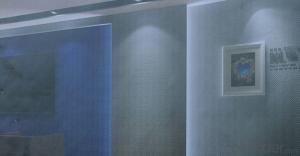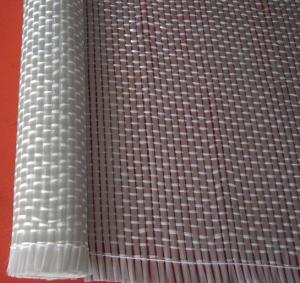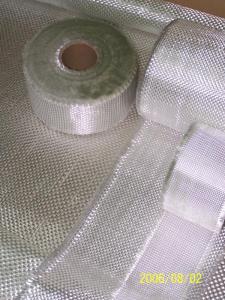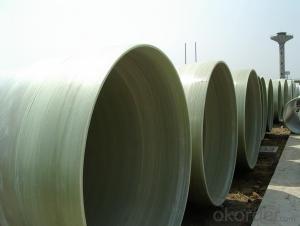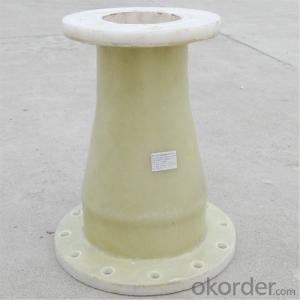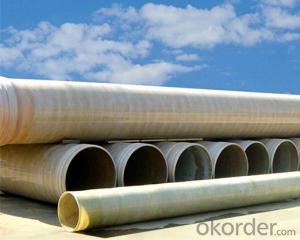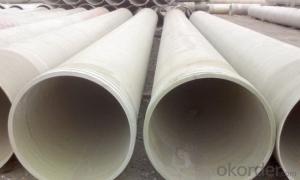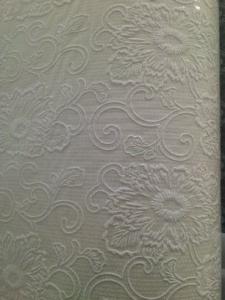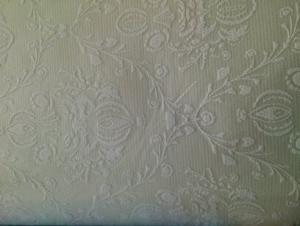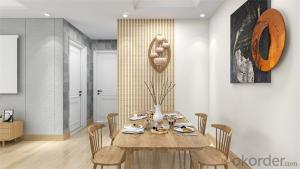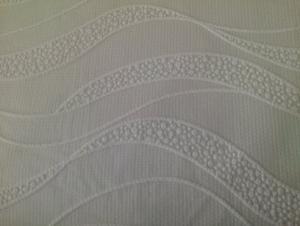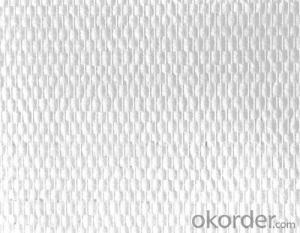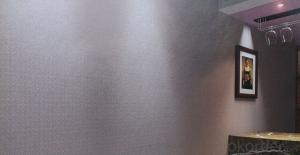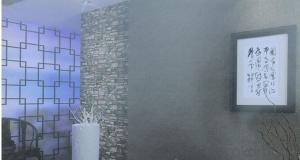Fiberglass Wallcovering Cloth Air Permeability 81704
- Loading Port:
- Shanghai
- Payment Terms:
- TT OR LC
- Min Order Qty:
- 100 m²
- Supply Capability:
- 100000 m²/month
OKorder Service Pledge
OKorder Financial Service
You Might Also Like
Fiberglass Wallcovering Cloth Air Permeability 81704
Specification of Wallcovering Cloth
.Environment-friendly
.Flame retardent
.Air permeability
.Waterproof
.Anti-corrosion
.Imcomparable strength
.Abundant patterns and colors
.Long life time
Packing Details
.Width:1m
.Length:25/50m
.Each roll of wallcovering cloth is wrapped in a shrinking polythene film,then put in carton
Introduction of wallcovering Cloth
Fiberglass wallcovering cloth,that combines the versatility of paint,from latex to epoxy,with the
strength and benefits of woven fiberglass textile yarns to meet the most demanding wall finish
requirments.Fiberglass textile yarns,as a kind of natural materials,are woven into various textures
and patterns and then treated with a natural starch binder for dimensional stability during the hanging
process.
Compared with traditional wall papers,fiberglass wall covering cloth has the following advantages:
Environment friendly,Flame Retardant,Air Permeability,Shock Resistance,Waterproofing,Anti-corrosion,Abundant Colors&Patterns.
Product Show

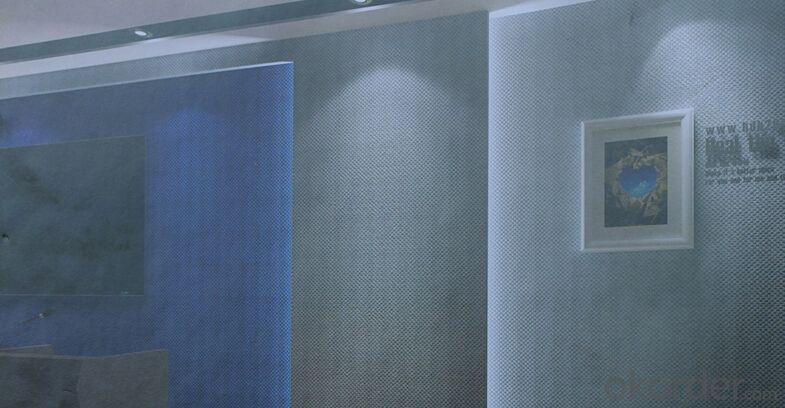
Application of Wallcovering Cloth
As a high-tech indoor decorating material,fiberglass wallcovering cloth is widely used in resident homes,
offices and shops and even cinemas,theatres,hotels and hospital faclilties,air ports,office buildings,shopping centers and schools.
Test Report
Our product has passed test by SGS as follows:
EN 12956:for determination of dimensions,straightness,spongeability and washability.
EN 12149:for determination of magration of heavy metals and certain other elements,of
vinyl monomer and of formaldehyde release.
EN 20105-B02:light solidity.
Our products had passed test of Fire Retardancy M1 Class by LINE
- Q:Can fiberglass wallcovering cloth be used in conjunction with textured wall finishes?
- Yes, fiberglass wallcovering cloth can be used in conjunction with textured wall finishes. Fiberglass wallcovering cloth is a versatile material that can be applied to various types of surfaces, including textured walls. It is designed to provide a smooth and even surface, hiding imperfections and creating a clean canvas for painting or other decorative finishes. Whether the textured wall finish is rough or has a pattern, the fiberglass cloth can be applied over it to create a smooth and seamless base. It is important to properly prepare the textured wall surface before applying the fiberglass cloth to ensure proper adhesion and durability. Overall, using fiberglass wallcovering cloth in conjunction with textured wall finishes can help enhance the appearance of the walls and provide a long-lasting and durable solution.
- Q:How durable is fiberglass wallcovering cloth?
- Known for its exceptional durability, fiberglass wallcovering cloth is a material renowned for its ability to withstand the test of time in various environments. Its composition, consisting of tightly woven fiberglass strands coated with a protective layer, attributes to its long-lasting nature. This construction renders it tear-resistant, puncture-resistant, and resistant to general wear and tear. Moreover, fiberglass wallcovering cloth exhibits high resistance to moisture, making it an ideal choice for areas with high humidity, such as bathrooms or kitchens. It remains unwarping and unshrinking even when exposed to moisture for extended periods. Additionally, it successfully resists the growth of mold and mildew, which enhances its durability and longevity. An additional advantage of fiberglass wallcovering cloth is its excellent fire-resistant properties. Being non-combustible and not contributing to the spread of flames, it proves to be a safe option for both commercial and residential applications. Furthermore, maintaining fiberglass wallcovering cloth is a hassle-free task. It can be easily cleaned with mild detergents or wiped down with a damp cloth without compromising its durability. Its resistance to fading or discoloration ensures that it retains its aesthetic appeal for years to come. In conclusion, fiberglass wallcovering cloth is an incredibly durable material that can withstand the demands of everyday use. Its ability to resist physical damage, moisture, fire, and mold makes it a reliable choice for both residential and commercial spaces.
- Q:Fiberglass (sea cloth) shortcomings
- The advantages and disadvantages of the fiberglass1, first of all, say shortcomings:A: the first investment costs relative to pure paint to be high, specific costs. If you spend three or four thousand dollars to get the following advantages, you will still feel the value,B: no flowery designs for wallpaper.Fiberglass itself is pure white, is secretly texture, but also keep the surface of the gentle, can be very refreshing and very plain paint, also can use red, warm paint. I think this is a matter of personal preference. Personally, I prefer something with implicit tension. It's not very colorful, but it's very attractive. Quartz ten more in line with my personality, is your choice.C: a wide range of processes, both brush paint the whole process, and wallpaper paving process.The rolling brush, paint and paste wall covering the two links that should be compared to the decoration
- Q:Does fiberglass wallcovering cloth have any specific installation requirements for humidity or moisture levels?
- Fiberglass wallcovering cloth has specific installation requirements regarding humidity and moisture levels. It is crucial to ensure that the surface where the cloth will be applied is clean, dry, and devoid of any moisture or humidity. Excessive humidity or moisture can adversely affect the adhesion and effectiveness of the fiberglass cloth, potentially resulting in bubbling, peeling, or the growth of mold. Ideally, the room's humidity level should be below 50% throughout the installation process. If the humidity level is higher, it is recommended to utilize dehumidifiers or air conditioning to bring it down to an acceptable range. Moisture meters can also be employed to check the moisture content in the walls or substrate to ensure it falls within the acceptable range. If moisture is an issue, it is advisable to address the underlying cause of the problem before installing the fiberglass cloth. This may involve fixing any leaks, enhancing ventilation, or resolving any other sources of excess moisture in the room. Following the manufacturer's instructions and guidelines for installation is also crucial, as they may provide specific recommendations for humidity and moisture levels. By adhering to these requirements, a successful installation and long-lasting performance of the fiberglass wallcovering cloth can be ensured.
- Q:How is fiberglass wallcovering cloth made?
- Fiberglass wallcovering cloth is created using a technique called fiberglass weaving. To begin, fiberglass yarns are produced by pulling molten glass through tiny holes to form thin, continuous strands. These strands are then coated with a sizing material to enhance their strength and flexibility. Next, the specialized looms interweave the fiberglass yarns to form a fabric. The weaving process follows specific patterns, such as plain weave or twill weave, to achieve the desired strength and texture of the fabric. Once the fabric is woven, it undergoes a finishing treatment to improve its performance and appearance. This treatment typically involves applying chemical coatings like acrylic or vinyl to increase durability, moisture and stain resistance, and ease of cleaning. Some wallcovering cloths may also be treated with fire-retardant chemicals for safety. After the finishing treatment, the fabric is either rolled onto large spools or cut into specific lengths and packaged for distribution. It is then ready for use as a wallcovering material, providing a long-lasting and visually appealing surface for walls in various residential, commercial, and industrial spaces. In summary, the process of manufacturing fiberglass wallcovering cloth involves producing fiberglass yarns, weaving them into a fabric, and applying finishing treatments to enhance its performance. This results in a versatile and durable material that enhances both the aesthetics and functionality of interior spaces.
- Q:Can fiberglass wallcovering cloth be used in conjunction with custom architectural elements or features?
- Certainly! Fiberglass wallcovering cloth can be utilized alongside custom architectural elements or features. This versatile material can be effortlessly shaped, molded, or trimmed to perfectly fit around unique architectural elements like columns, archways, or decorative features. By using it to cover the walls, a seamless and uniform appearance can be achieved, while also ensuring the durability and protection of the underlying surfaces. Moreover, fiberglass wallcovering cloth comes in a wide array of textures, patterns, and colors, enabling customization and seamless integration with the overall design scheme of the architectural elements or features. In summary, fiberglass wallcovering cloth provides the flexibility and compatibility needed for interior design projects involving custom architectural elements, making it an ideal choice.
- Q:Is special equipment needed to install fiberglass wallcovering cloth?
- Typically, the installation of fiberglass wallcovering cloth necessitates the use of special equipment. This is due to the fact that fiberglass wallcovering cloth is a specialized material that demands specific tools and techniques for correct installation. To properly install it, one may require various equipment such as a wallpaper smoother, a trowel or putty knife, a paint roller or brush, a utility knife, and a wallpaper adhesive. Moreover, it would be advantageous to possess a measuring tape, a level, and a straight edge to achieve accurate and precise installation. By utilizing the appropriate tools and equipment, one can guarantee a successful and professional-looking installation of fiberglass wallcovering cloth.
- Q:Can fiberglass wallcovering cloth be used in conjunction with decorative planters or green walls?
- Fiberglass wallcovering cloth can indeed be utilized alongside decorative planters or green walls. Known for its versatility, this material is commonly employed in construction and interior design for reinforcement and protection purposes. When considering decorative planters or green walls, the utilization of fiberglass wallcovering cloth offers numerous advantages. To begin with, it possesses excellent durability and moisture resistance, making it suitable for areas near planters or green walls where water or humidity may be present. Furthermore, fiberglass cloth is highly flexible and easily molded or shaped. This property allows it to flawlessly cover irregular surfaces and conform to the contours of planters or green walls. Thus, it becomes an ideal material for achieving a smooth and uniform finish, ultimately enhancing the overall aesthetic appeal. Moreover, fiberglass wallcovering cloth typically exhibits fire-resistant properties and provides effective insulation. These attributes prove advantageous in areas where fire safety or temperature control is a concern for planters or green walls. In conclusion, the integration of fiberglass wallcovering cloth with decorative planters or green walls contributes to both visually appealing and functional designs. However, it is crucial to ensure proper installation techniques and materials are employed to guarantee the structure's longevity and stability.
- Q:Does fiberglass wallcovering cloth reduce noise transmission?
- Indeed, noise transmission can be reduced by the utilization of fiberglass wallcovering cloth. Fiberglass possesses renowned properties for absorbing sound, and its application as a wallcovering aids in the suppression and absorption of sound waves. This proves advantageous in diminishing the extent of noise that traverses through walls, particularly in settings where noise regulation holds significance, for example, offices, hospitals, or recording studios. Nevertheless, it is crucial to acknowledge that the efficacy of fiberglass wallcovering cloth in decreasing noise transmission can fluctuate contingent upon variables such as cloth thickness, wall construction, and the comprehensive acoustic design of the area.
- Q:Can fiberglass wallcovering cloth be used in soundproofing applications?
- Yes, fiberglass wallcovering cloth can be used in soundproofing applications. Its dense and fibrous composition helps to absorb and dampen sound waves, reducing noise transmission through walls and other surfaces.
1. Manufacturer Overview |
|
|---|---|
| Location | |
| Year Established | |
| Annual Output Value | |
| Main Markets | |
| Company Certifications | |
2. Manufacturer Certificates |
|
|---|---|
| a) Certification Name | |
| Range | |
| Reference | |
| Validity Period | |
3. Manufacturer Capability |
|
|---|---|
| a)Trade Capacity | |
| Nearest Port | |
| Export Percentage | |
| No.of Employees in Trade Department | |
| Language Spoken: | |
| b)Factory Information | |
| Factory Size: | |
| No. of Production Lines | |
| Contract Manufacturing | |
| Product Price Range | |
Send your message to us
Fiberglass Wallcovering Cloth Air Permeability 81704
- Loading Port:
- Shanghai
- Payment Terms:
- TT OR LC
- Min Order Qty:
- 100 m²
- Supply Capability:
- 100000 m²/month
OKorder Service Pledge
OKorder Financial Service
Similar products
New products
Hot products
Hot Searches
